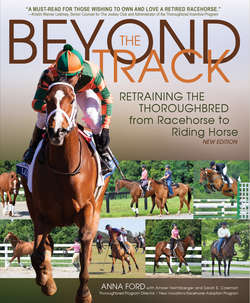Читать книгу Beyond the Track - Anna Morgan Ford - Страница 11
На сайте Литреса книга снята с продажи.
Understanding the OTTB
ОглавлениеTo better imagine what a horse is going through when he leaves the track and starts a new career as a riding horse, try to imagine yourself in a similar situation. Simply put, think about what it would be like to lose the only job that you have ever known and leave all your friends and everything familiar to you. Then, you move to a new town, where you start a job for which you have no training or prior experience. In this new place, no one speaks your language, the food is nothing you have ever eaten before, and the schedule is entirely different from your usual routine. This is what it is like for a Thoroughbred to leave life at the track and go on to a new career—he is completely out of his comfort zone.
1.2 A–C These three ex-racehorses were adopted through New Vocations and have gone on to excel in new careers. Discreet Dancer competing as a show jumper with Armand Leone (A). “Tooey” and Kari Briggs are exploring lower level dressage—here they are pictured at Tooey’s first show (B). Velvet Cat, shown here in early schooling, is now used for Pony Club (C).
It helps if the person adopting an ex-racehorse—in this case, you—knows something about the horse’s previous experiences as you assist him in the transition to his new lifestyle. Getting to know your new horse is like getting to know a new friend—you want to find out about his personality, background, and what makes him tick. It will take a little time together before you understand his personality, his likes and dislikes, but he will never be able to sit down with you over coffee and share the story of his past. Luckily, many Thoroughbred breeding facilities and racing stables are managed somewhat similarly, so you can better understand your OTTB’s background by learning a little about racing as a whole. While by no means a thorough lesson in what is a complex industry with many layers and traditions, I will provide a glimpse of what happens on and off the track, explaining what most Thoroughbreds likely experience at each stage of their race training.
1.3 Many young Thoroughbreds are turned out with their mothers, along with other mares and foals their age. This allows them to gain social skills, strength, and a taste for being competitive.
